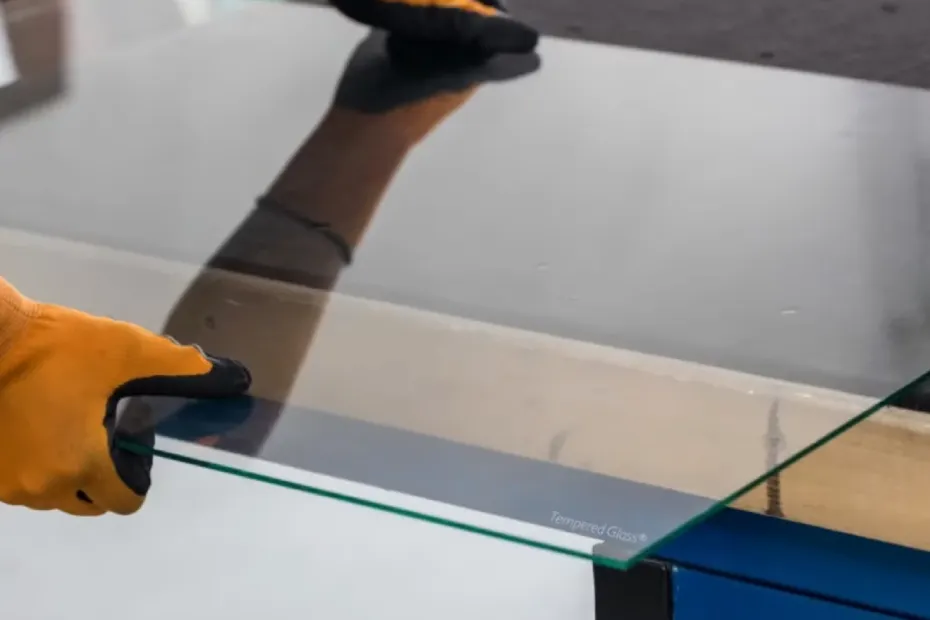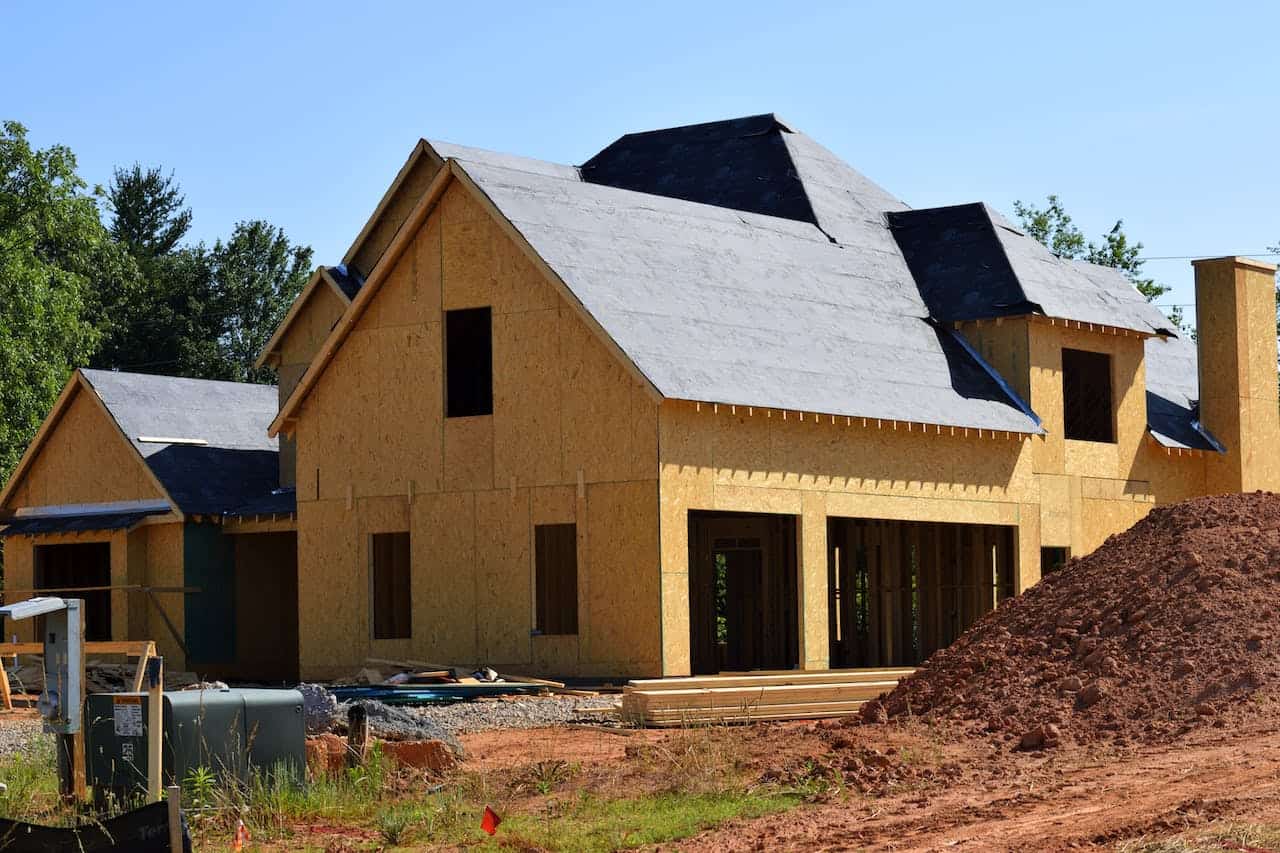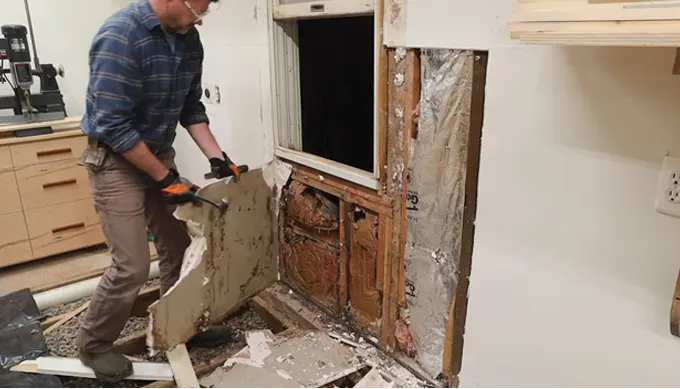WoodenuKnow.com is a participant in the Amazon Services LLC Associates Program, an affiliate advertising program designed to provide a means for sites to earn advertising fees by advertising and linking to Amazon.com and may earn from qualifying purchases.
Beveled glasses have become ubiquitous in modern woodworking projects, used in incorporation with wooden entry doors, windows, or tabletops. However, the fragile nature of beveled glass makes it prone to breakage and damage, requiring special attention to enhance its durability.
Tempering is an essential process that is generally applied to standard glass to make it stronger. But, as beveled glasses differ from standard glass, the question arises: is it possible to temper beveled glass to enhance its strength without affecting its aesthetic appeal?
You can temper beveled glass, but it requires meticulous attention. With its angled edges, beveled glass poses a unique challenge in achieving uniform heating.
To temper beveled glass, you have to maintain a consistent temperature throughout the glass, ensuring that the angled edges are heated evenly.
We will discuss in detail the step-by-step procedure involved in tempering beveled glass so you can use it confidently in woodworking projects that need durability.
How to Temper Beveled Glass: Step-By-Step Procedures
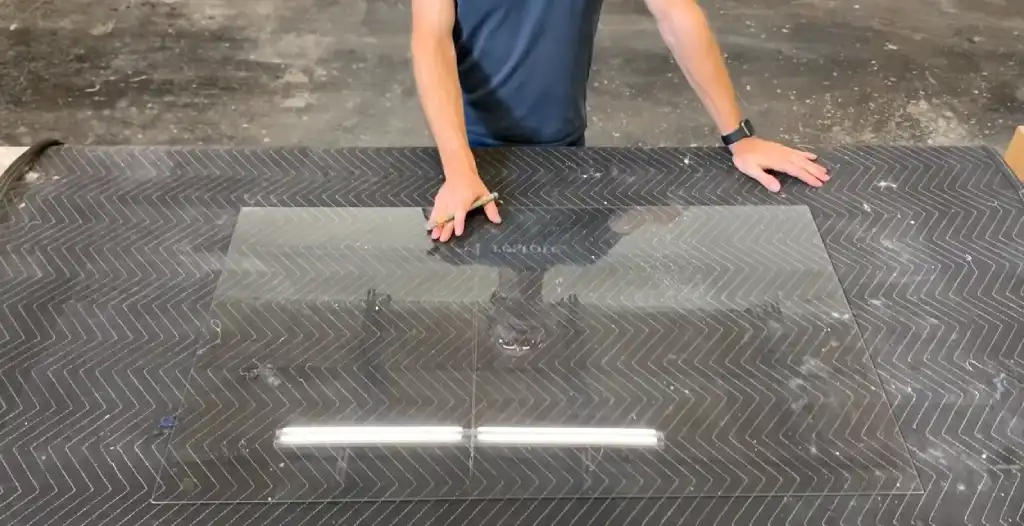
To temper beveled glass for use with wooden entry doors, windows, or tabletops, you need to follow a series of precise steps, which include:
- Step 1: Cut and shape the beveled glass
- Step 2: Inspect for imperfections and sand the edges
- Step 3: Wash the glass
- Step 4: Place in the tempering oven and heat the glass
- Step 5: Remove and quench the beveled glass
- Step 6: Check for quench marks
Step 1: Cut and Shape the Beveled Glass
Before tempering the beveled glass, you must cut and shape it according to the measurements of your wooden project. Attempting to modify the glass post-tempering may compromise its strength and safety.
To begin cutting and shaping beveled glass, carefully mark the glass with the desired dimensions. Use a glass cutter to score the glass along the marked lines, applying consistent pressure for a clean cut.
For circular shapes, a glass-cutting compass can help achieve an accurate circumference. If you work with a rectangular shape, you can use a straight edge or a T-square to guide the glass cutter along the marked lines.
Once you have scored the glass, press down with a dowel or similar tool on either side of the cut to break it along the score line. Try to make the break as smooth as possible, as any jagged edges may cause imperfections in the tempered glass.
Step 2: Inspect for Imperfections and Sand the Edges
After cutting and shaping the beveled glass, you need to inspect the glass for any imperfections that may compromise the tempering process. Thoroughly examine the glass for cracks, bubbles, or any other defects.
Sand the edges of the glass using wet sandpaper until they are smooth and eliminate any sharp edges that could pose a risk during subsequent handling. When sanding, make sure you do it slowly and thoroughly in order to achieve the desired results.
Step 3: Wash the Glass
Now, wash the glass thoroughly to remove any dust or other contaminants from sanding. You can use cool water to ensure the glass is free from loose materials that can interfere with the tempering process. Dry the glass completely using a lint-free cloth or paper towel.
Step 4: Place in the Tempering Oven and Heat the Glass
It is now time to temper the beveled glass. Position the glass in the tempering oven or kiln with the beveled side facing the rollers to achieve the desired tempered beveled glass. Turn on the oven and set it to the recommended temperature for your type of glass.
The tempering process requires the glass to be heated to a minimum temperature of 600 °C (1,112 °F). The heating time will depend on factors such as glass thickness and oven temperature. Typically, the process takes anywhere from 3 to 10 minutes. Ensure that the glass has been heated evenly to achieve consistent results.
Step 5: Remove and Quench the Beveled Glass
Once the glass has been heated to the necessary temperature, you can carefully remove it from the oven and begin quenching. Use tongs or a specialized paddle designed for handling hot glass to ensure safe handling.
Place the hot glass on a suitable surface that can withstand the heat and weight of the glass. Avoid touching the hot glass directly with your bare hands, as it can cause severe burns.
Immediately after removing the glass from the oven, initiate the quenching process. This involves subjecting the glass to short bursts of cool air for 3-10 seconds.
The purpose of quenching is to rapidly cool down the glass, which helps to increase its strength and durability.
Step 6: Check for Quench Marks
Once the beveled glass has been quenched, examine it using polarized glasses to identify “quench marks.” These marks are essential indicators for ensuring the glass’s strength and safety.
Shine a light through the glass to make the quench marks more visible. If the glass does not display quench marks, it has not been appropriately tempered, and you need to temper it again.
Safety Measures During Beveled Glass Tempering
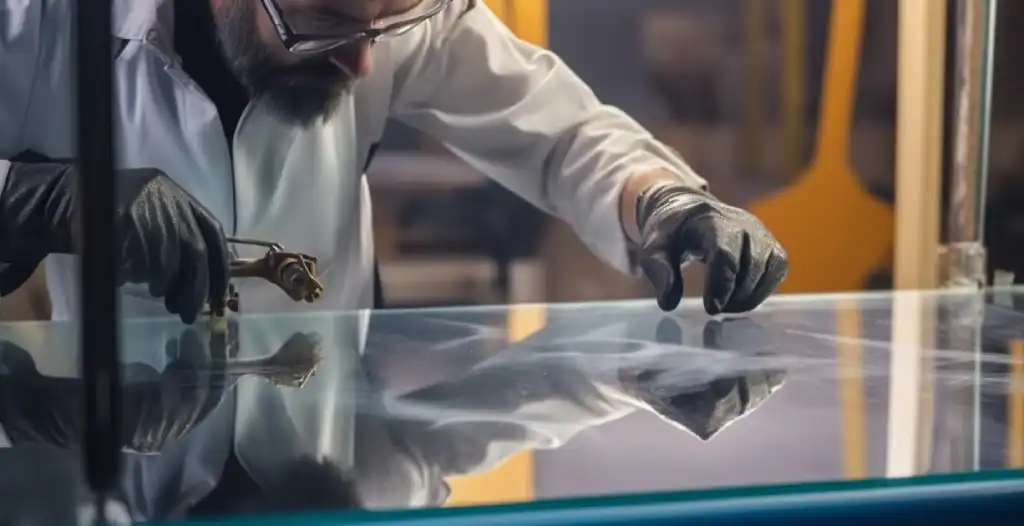
To ensure your safety when tempering beveled glass, you should take the following precautions:
1. Wear Personal Protective Equipment (PPE)
When tempering beveled glass, ensure that you put on the right safety gear, including thermal gloves, eye protection glasses, and protective clothing.
Heat-resistant gloves are essential to shield your hands from the high temperatures involved in the tempering process. Safety glasses provide eye protection against any flying glass fragments or particles. Additionally, wearing protective clothing, such as long sleeves and pants, helps prevent direct contact with hot glass surfaces.
2. Check Equipment and Tools
Before starting the tempering process for beveled glass, thoroughly inspect all the equipment and tools for any defects or malfunctions. If any defects or malfunctions are identified, address them immediately before proceeding with the tempering process.
3. Use Proper Handling Techniques
When handling beveled glass, it’s essential to use proper techniques to prevent breakage and injuries.
Be mindful of the weight and dimensions of the glass, as it may require the assistance of another person or specialized lifting equipment. When transporting the glass, ensure it’s secured and supported evenly to prevent any stress or pressure points that could cause it to crack or shatter.
Additionally, avoid placing excessive pressure on the beveled edges, as they’re more vulnerable to damage.
4. Avoid Sharp Edges
To ensure the safety of the tempering process for beveled glass, you have to smooth and eliminate any defects on the edges, minimizing the risk of injuries. Sharp edges can pose a significant hazard when handling tempered beveled glass.
5. Temperature Monitoring
Monitoring temperatures is a key safety measure during beveled glass tempering. When placing the glass in the tempering oven, be vigilant about maintaining the required temperature for effective tempering.
Utilize specialized equipment to ensure precise temperature control, especially considering the unique heating requirements for beveled glass. Monitor and adjust the temperature settings as needed throughout the tempering process to guarantee the glass achieves the desired hardness and safety features.
What Advantages Does the Tempering Process Bring to Beveled Glass?
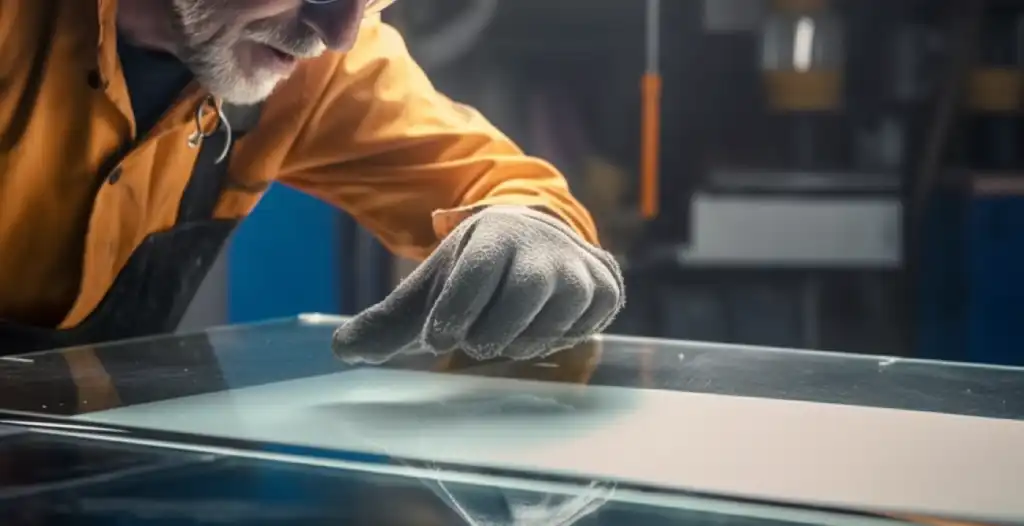
When beveled glass undergoes the tempering process, several advantages are gained, including the following:
1. Enhanced Strength
As tempered beveled glass increases strength, it is ideal for use on wooden structures such as windows, doors, or other structures in your home or office. This enhanced strength makes tempered beveled glass about six times stronger than regular glass, increasing its resistance to impact and thermal shock.
The robustness of tempered beveled glass complements the structural integrity of wooden elements in your woodworking projects, ensuring durability and longevity.
2. Enhanced Safety
Tempering is an effective method to enhance the safety of beveled glass. When tempered glass breaks, it shatters into small, circular pieces rather than sharp, jagged fragments.
This fracture pattern reduces the risk of serious injury, making tempered beveled glass suitable for applications where human interaction is frequent, such as doors and windows.
3. Scratch Resistance
Tempered beveled glass offers significant advantages in terms of scratch resistance, providing a durable and clear surface for woodworking applications like tabletops. That means that even with regular use, the surface of tempered beveled glass will remain free from scratches and retain its original clarity.
4. Temperature Resistance for Varied Environments
When tempering beveled glass, you can expect enhanced temperature resistance, allowing it to withstand varied environments and providing several advantages.
Tempered glass is known for handling temperature fluctuations without compromising its structural integrity. This makes it suitable for use in environments with varying temperature conditions, such as near stoves or fireplaces.
Compared to untreated glass, tempered glass can withstand higher temperature differentials, making it less prone to breakage due to sudden temperature changes.
The tempering process strengthens the glass, creating a surface more resistant to thermal stress. This property is particularly valuable for beveled glass used in outdoor applications or in areas where temperature variations are common.
What is the recommended thickness for edges when tempering beveled glass?
For optimal tempering of beveled glass, it’s recommended to have a thickness of approximately 3.8mm to 4mm for the edges. This specific thickness is essential to ensure the integrity and strength of the tempered glass. Adhering to this recommendation can avoid potential issues such as breakage during the tempering process.
Also, this recommended thickness contributes to the overall durability and resilience of the tempered glass, making it ideal for woodworking projects like doors, windows, and tabletops.
What is the maximum heat that tempered beveled glass can endure?
Tempered beveled glass has a remarkable maximum heat tolerance, withstanding temperatures up to 470 degrees Fahrenheit (243 degrees Celsius).
This high heat resistance is a key characteristic that makes it suitable for various applications, particularly in woodworking projects where the glass may be exposed to fluctuating temperatures.
Whether used in doors, windows, or tabletops, tempered beveled glass maintains its structural integrity and safety even under extreme temperatures. This exceptional heat endurance ensures the glass remains reliable and durable, making it an ideal choice for your woodworking needs.
With its ability to withstand up to 470 degrees Fahrenheit, tempered beveled glass provides a robust solution that can endure the demands of high-heat environments.
Can you place hot dishes on a wooden tabletop covered by tempered beveled glass?
You can confidently place hot dishes on a tabletop covered with tempered beveled glass because it significantly enhances the heat resistance of the glass.
The tempering process involves heating the glass to high temperatures and then rapidly cooling it, creating internal stresses that increase its strength and durability. This makes tempered beveled glass capable of withstanding elevated temperatures without cracking or shattering.
Heat-resistant glass protects wooden tabletops from damage caused by hot cookware. Additionally, the tempered glass provides a smooth and level surface, ensuring stability and preventing any potential damage to the wooden surface.
How much pressure in pounds per square inch (PSI) can tempered beveled glass withstand?
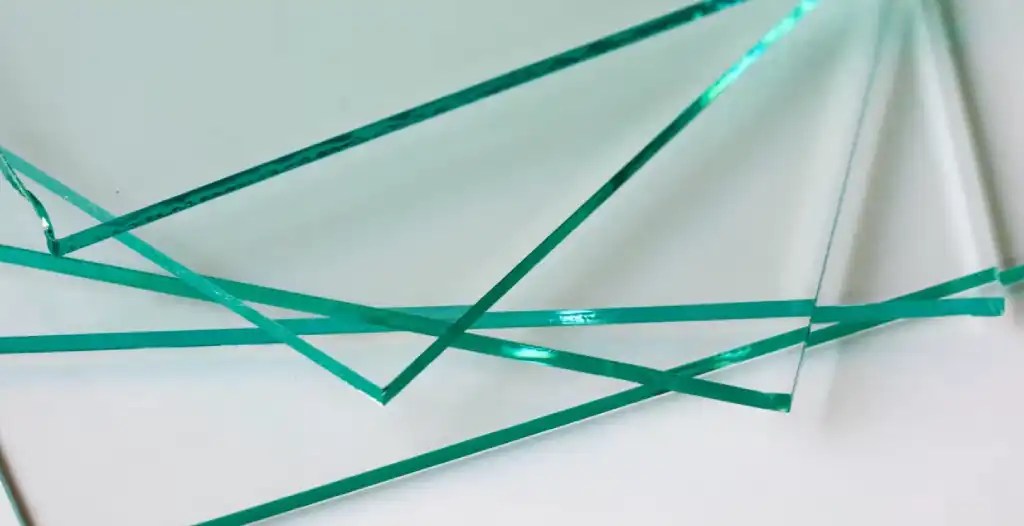
Tempered beveled glass can withstand significant pressure, generally adhering to federal specifications that mandate a surface compression of 10,000 PSI or more. This ensures the glass’s enhanced strength and durability, making it a robust choice for various applications.
Typically, tempered glass, including beveled varieties, breaks at approximately 24,000 PSI, demonstrating its resilience under high-pressure conditions.
This strength is a key feature that makes tempered beveled glass suitable for woodworking projects, such as incorporating it into doors, windows, or tabletops, where the glass may encounter varying stress levels.
Take Advantage of the Strength and Elegance of Tempered Beveled Glass
Tempering beveled glass is indeed possible and brings several advantages to its strength and durability. You have to cut and shape the glass with precision, ensuring it aligns seamlessly with your woodworking project.
The meticulous inspection for imperfections, sanding, and thorough washing sets the foundation for effective tempering. Placing it in the tempering oven at the right temperature, followed by careful removal and quenching, enhances its strength significantly.
Checking for quench marks ensures the glass meets safety standards. With enhanced strength, scratch resistance, and temperature endurance, tempered beveled glass is aesthetically pleasing and a durable choice for your woodworking endeavors.

